Book Title: Jainaism in Ancient Bengal Author(s): R C Majumdar Publisher: Z_Mahavir_Jain_Vidyalay_Suvarna_Mahotsav_Granth_Part_1_012002.pdf and Mahavir_Jain_Vidyalay_Suvarna_ View full book textPage 7
________________ 136 : SHRI MAHAVIRA JAINA VIDYALAYA GOLDEN JUBILEE VOLUME of the three säkchas in Bengal mentioned in the Kalpa Sutra may also be referred to the same period, if not before. We may therefore reasonably assume that by the first century A.D. Jainism was firmly established in different parts of Bengal, including Rādha whose people had once been so rude to Mahāvīra. An inscription, discovered at Mathurā but now in the Calcutta Museum, records the erection of a Jaina image in the year 62 at the request of a Jaina monk who was an inhabitant of Rāră. Rără is very probably Rādhā, a well-known variant of Rādha (in Bengal), and the date is to be referred to the Kuşāņa era and therefore equivalent to about 150 A.D.19 The next definite evidence of Jainism in Bengal is furnished by a copper-plate grant, dated year 159 (of the Gupta era, and equivalent to 479 A.D.) found in Paharpur in North Bengal famous for the big Buddhist Stūpa and monastery of the Pāla period (8th century A.D.). The grant records the endowment, by a Brāhmaṇa couple, of lands for the maintenance of worship with sandal, incense, flowers, lamps, etc., of the divine Arhats at the vihara of Vața-Gohāli which was presided over by the disciples and the disciples of disciples of the Ni(r)granthaśramaņācāryya (Jaina preceptor) Guhanandin, belonging to the Pañcastūpa section (nikāya) of Kāśī (Vārāṇasī).20 This record proves the existence of a Jaina temple with images of the Arhats, and a monastery, existing for at least three generations, i. e., for nearly a hundred years, or more, or since the fourth century A.D. at the latest. It also shows that even those who were not professed Jainas, including the Brāhmaṇas, had the highest reverence for Jaina Arhats and regarded it as a pious duty to endow the Jaina temples for defraying the expenses of its daily worship. Jainism made very good progress in Bengal in the next century. The Chinese pilgrim Hiuen Tsang, who visited this region about 638 A.D., describes Jainism as the dominant religion in two of the most important States, one in North and the other in South-eastern Bengal. Referring to Pundravardhana, a big flourishing kingdom in North Bengal, the pilgrim says: “There were twenty Buddhist monasteries. Deva-temples were 100 in number, and the followers of various sects lived pell-mell, the Digambara Nirgranthas being very numerous. "21 Referring to Samatata or Lower Bengal to the east of 19 R. D. Banerji, Pālas of Bengal, p. 72. 20 Ep. Ind., XX, pp. 59 ff. 21 Watters, On Yuan Chwang, II. 184. Jain Education International For Private & Personal Use Only www.jainelibrary.orgPage Navigation
1 ... 5 6 7 8 9
